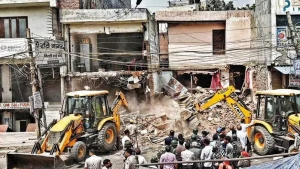New Delhi – The Delhi High Court On Encroachers has delivered a significant verdict that fundamentally alters the landscape of public land occupation disputes in the national capital. In a comprehensive ruling, Justice Dharmesh Sharma categorically stated that encroachers cannot claim any inherent right to continue occupying public land while their rehabilitation claims remain pending resolution. This landmark judgment by the Delhi High Court On Encroachers affects over 200 residents of Bhoomiheen Camp in southeast Delhi’s Govindpuri area.
The court’s decision represents a decisive stance against unauthorized occupation of public spaces, emphasizing that such encroachments are detrimental to public welfare. The Delhi High Court On Encroachers ruling comes after residents challenged the Delhi Development Authority’s decision to demolish their temporary structures and refuse rehabilitation under the Delhi Slum and JJ Rehabilitation and Relocation Policy, 2015.
Legal Framework Behind the Ruling

Justice Dharmesh Sharma’s comprehensive analysis in the Delhi High Court On Encroachers case established clear legal precedents regarding the relationship between encroachment and rehabilitation rights. The court emphasized that rehabilitation rights arise exclusively from prevailing policies and cannot be used as justification for continued illegal occupation of public land.
The Delhi High Court On Encroachers judgment specifically noted that determining eligibility for rehabilitation constitutes a separate administrative process from removing encroachers from public property. This distinction proves crucial in understanding the court’s rationale, as it establishes that rehabilitation proceedings cannot halt or delay the removal of unauthorized occupants from government land.
Also Read About The Bharatiya Bhasha Anubhag: Amit Shah Launches Revolutionary Indian Languages Initiative
Policy Compliance and Eligibility Criteria

The Delhi High Court On Encroachers ruling extensively examined the 2015 policy requirements that residents failed to meet. According to the court’s findings, the petitioners could not satisfy essential threshold criteria necessary for rehabilitation consideration. The Delhi Development Authority identified multiple grounds for ineligibility, including the absence of separate ration cards for upper floor structures, residing on unauthorized second floors, and missing names from voter lists prior to January 2015.
These stringent requirements, as validated by the Delhi High Court On Encroachers decision, demonstrate the systematic approach authorities must follow when determining rehabilitation eligibility. The court’s analysis revealed that proper documentation and compliance with established timelines remain non-negotiable prerequisites for claiming rehabilitation benefits.
Constitutional Rights Versus Public Interest
The residents’ legal challenge centered on claims that demolition proceedings violated their constitutional right to shelter. However, the Delhi High Court On Encroachers ruling prioritized broader public interest over individual claims of housing rights. The court determined that allowing continued occupation pending rehabilitation decisions would unduly impede essential public development projects.
This balancing act between individual rights and collective welfare forms the cornerstone of the Delhi High Court On Encroachers judgment. Justice Sharma emphasized that permitting indefinite occupation of public land would create precedents harmful to urban development and efficient land utilization for public benefit.
Impact on Multiple Petitioners
The Delhi High Court On Encroachers case involved complex legal challenges due to the involvement of multiple parties with varying circumstances. The court noted that the writ petitions suffered from fundamental flaws, including misjoinder of parties with different causes of action. This procedural complexity highlighted the need for individual assessment rather than collective litigation approaches.
Despite dismissing the majority of claims, the Delhi High Court On Encroachers ruling provided targeted relief to specific residents. Twenty-six individuals whose appeals were allowed by appellate authorities but subsequently rejected by the Delhi Development Authority received favorable consideration. Additionally, the court directed provision of alternative accommodation for another resident within six weeks.
Historical Context of the Settlement
The Delhi High Court On Encroachers case involved a nearly three-decade-old slum cluster that housed migrants from various states including Uttar Pradesh, Bihar, and West Bengal. These residents primarily worked in low-income occupations such as domestic help, factory labor, and local shop assistance, representing Delhi’s vulnerable migrant population seeking affordable housing solutions.
The long-standing nature of this settlement added complexity to the Delhi High Court On Encroachers deliberations, as residents argued their extended presence should constitute some form of legitimate claim. However, the court maintained that duration of occupation cannot legitimize unauthorized use of public property.
Precedential Value for Future Cases
The Delhi High Court On Encroachers judgment establishes important legal precedents for similar disputes across Delhi and potentially other urban centers. The ruling clarifies that rehabilitation policies serve as administrative frameworks rather than sources of absolute rights that can prevent lawful demolition of unauthorized structures.
This precedential aspect of the Delhi High Court On Encroachers decision will likely influence future litigation strategies and government approaches to slum clearance operations. The court’s emphasis on separating rehabilitation eligibility from occupation rights provides clear guidance for both authorities and affected communities.
Implementation and Enforcement

Following the Delhi High Court On Encroachers ruling, the Delhi Development Authority proceeded with demolition activities after the court dismissed related writ petitions on May 26 and May 30. The systematic approach to enforcement demonstrates the practical implementation of legal principles established in the judgment.
The Delhi High Court On Encroachers decision thus represents more than theoretical legal doctrine; it provides actionable guidance for urban development authorities dealing with encroachment challenges. The ruling balances humanitarian concerns with administrative efficiency and public interest protection.
Closing Statements
The Delhi High Court On Encroachers judgment marks a significant development in Delhi’s urban planning and housing policy landscape. By clearly delineating the boundaries between rehabilitation rights and occupation claims, the court has provided essential clarity for future policy implementation and legal proceedings involving public land disputes.

